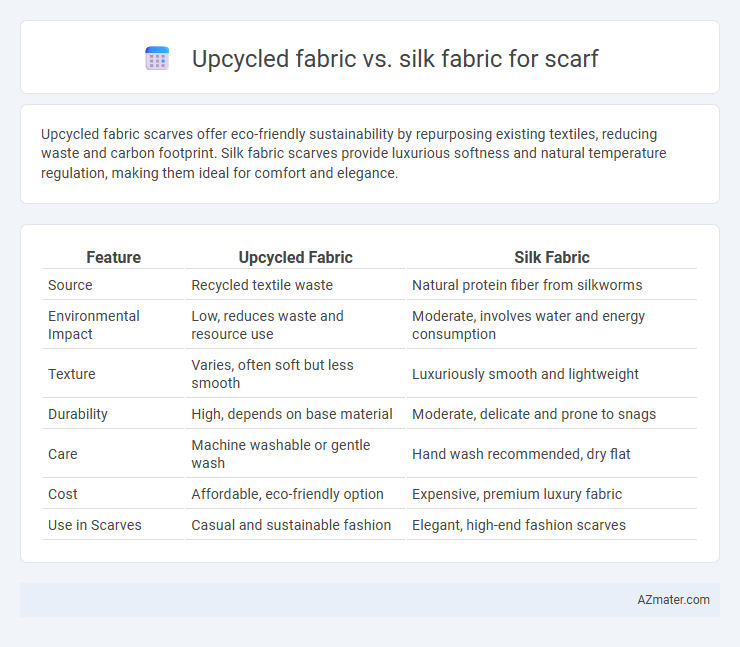Upcycled fabric scarves offer eco-friendly sustainability by repurposing existing textiles, reducing waste and carbon footprint. Silk fabric scarves provide luxurious softness and natural temperature regulation, making them ideal for comfort and elegance.
Table of Comparison
| Feature | Upcycled Fabric | Silk Fabric |
|---|---|---|
| Source | Recycled textile waste | Natural protein fiber from silkworms |
| Environmental Impact | Low, reduces waste and resource use | Moderate, involves water and energy consumption |
| Texture | Varies, often soft but less smooth | Luxuriously smooth and lightweight |
| Durability | High, depends on base material | Moderate, delicate and prone to snags |
| Care | Machine washable or gentle wash | Hand wash recommended, dry flat |
| Cost | Affordable, eco-friendly option | Expensive, premium luxury fabric |
| Use in Scarves | Casual and sustainable fashion | Elegant, high-end fashion scarves |
Introduction to Upcycled and Silk Fabrics
Upcycled fabric for scarves involves repurposing pre-existing textiles, reducing waste and environmental impact by giving new life to discarded materials. Silk fabric, known for its natural protein fibers produced by silkworms, offers unparalleled softness, sheen, and breathability, making it a luxurious choice for scarves. Choosing between upcycled and silk fabric balances sustainability efforts with the desire for traditional elegance and tactile comfort in fashion accessories.
Environmental Impact: Upcycled Fabric vs Silk
Upcycled fabric scarves significantly reduce environmental impact by repurposing textile waste, minimizing landfill contributions and lowering resource consumption compared to producing new silk. Silk fabric production involves high water usage, intensive energy consumption, and the use of chemicals in sericulture and processing, contributing to ecological strain. Choosing upcycled fabric supports sustainable fashion by conserving natural resources and reducing pollution throughout the scarf's lifecycle.
Sourcing and Production: How Each Fabric is Made
Upcycled fabric for scarves is sourced from pre-existing textiles, reducing waste by repurposing discarded garments or fabric scraps through processes like cutting, sorting, and sometimes dyeing to create unique, eco-friendly materials. Silk fabric, derived from silkworm cocoons, undergoes a labor-intensive production involving sericulture, harvesting, reeling the filaments, and weaving to produce smooth, luxurious scarves. The upcycled fabric emphasizes sustainability and resource efficiency, while silk focuses on natural protein fiber extraction and traditional manufacturing techniques.
Aesthetic Qualities: Texture, Color, and Design
Upcycled fabric scarves offer a unique tactile experience with varied textures resulting from repurposed materials, often showcasing eclectic color combinations and one-of-a-kind designs that reflect sustainability and creativity. Silk fabric scarves provide a smooth, luxurious texture with a natural sheen, displaying vibrant, rich colors and intricate, delicate patterns that exude elegance and timeless beauty. The choice between upcycled and silk fabric scarves balances the preference for artisanal, eco-friendly aesthetics against classic sophistication and refined visual appeal.
Durability and Longevity Comparison
Upcycled fabric scarves often exhibit high durability due to the repurposing of sturdy materials like denim or cotton blends, which can withstand frequent wear and washing. Silk scarves, while luxurious, are more delicate and prone to snags, tears, and color fading, requiring careful handling to maintain longevity. Choosing upcycled fabric enhances scarf durability and sustainability, whereas silk offers elegance but demands more delicate care for extended use.
Comfort and Wearability: Skin Feel and Breathability
Upcycled fabric scarves often provide enhanced breathability and a unique softness due to the blend of recycled fibers, making them ideal for sensitive skin and extended wear. Silk fabric scarves excel in smoothness and natural temperature regulation, offering a luxurious, lightweight feel that adapts well to varying climates. Both materials deliver high comfort and wearability, but upcycled fabrics appeal to eco-conscious wearers seeking durability, while silk emphasizes elegance and softness against the skin.
Versatility in Styling Scarves
Upcycled fabric scarves offer exceptional versatility in styling due to their unique textures and patterns derived from recycled materials, allowing for creative and eco-conscious fashion statements. Silk fabric scarves provide smooth, luxurious drape and vibrant color intensity, making them ideal for elegant, polished looks suitable for both casual and formal occasions. Both fabrics enable diverse styling options, but upcycled scarves emphasize sustainability and individuality, while silk scarves highlight timeless sophistication.
Price and Accessibility
Upcycled fabric scarves are generally more affordable due to the use of reclaimed materials, making them accessible to budget-conscious consumers and eco-friendly shoppers. Silk scarves, however, command higher prices because of the natural fiber's luxurious texture and labor-intensive production, often limiting accessibility to premium markets. The availability of upcycled fabric varies widely depending on local textile recycling initiatives, while silk is consistently accessible through established global supply chains.
Ethical Considerations: Sustainable Fashion Choices
Upcycled fabric for scarves significantly reduces textile waste by repurposing existing materials, aligning with sustainable fashion principles and minimizing environmental impact. Silk fabric, while natural and biodegradable, often involves resource-intensive production and raises concerns about animal welfare due to sericulture practices. Choosing upcycled fabric supports ethical consumerism by promoting circular economy models and decreasing reliance on resource-heavy silk production.
Final Verdict: Which Fabric is Best for Scarves?
Upcycled fabric offers an eco-friendly and sustainable choice, characterized by unique patterns and durability, making it ideal for environmentally conscious scarf buyers. Silk fabric provides luxurious softness, natural sheen, and excellent breathability, favored for its elegance and comfort in high-end scarves. The best fabric depends on personal priorities: sustainability and individuality lean toward upcycled fabric, while luxury and traditional appeal favor silk.

Infographic: Upcycled fabric vs Silk fabric for Scarf
 azmater.com
azmater.com